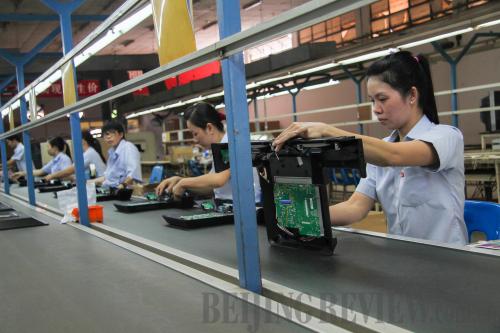
A factory of Chinese home appliances giant TCL in Ho Chi Minh City, Viet Nam (XINHUA)
Resilience in adversity
To promote the country's economic restructuring and stabilize the real economy, the People's Bank of China, the central bank, announced a cut of commercial banks' reserve requirement ratios and reduction of interest rates on August 25. It's the fourth reduction of reserve requirement ratios in nearly seven months and the fifth interest rate cut in nearly nine months.
Economic indicators have been pointing to a slowdown for quite some time. China posted a 7-percent growth in the second quarter of 2015, unchanged from the first quarter and the lowest quarterly growth rate since 2009.
Mei said it's unlikely for China to sustain high-speed growth against the backdrop of sluggish global recovery.
"Growth is slowing, but to levels enviable in any developed country and emerging markets," Mei said.
"The United States has been considered to have achieved 'robust growth' in recent years, with less than 3-percent annual growth. If so, why should China's 7-percent growth be considered as an 'economic crash' or even cause for worry? Is it really an objective comparison?" Mei questioned.
According to Wang Bao'an, Commis-sioner of the National Bureau of Statistics, although China has kissed goodbye to its breakneck expansion over the past decade, the 7-percent growth is a quite remarkable figure compared to both developed countries and other developing countries with similar conditions to China.
"As the world's second largest economy with such a humongous economic aggregate, the 1-percent increase in the GDP now means much more than before," Wang said.
China's contribution to global growth stood at 25.8 percent in 2014, higher than any other country in the world, Wang claimed.
Except for a 7-percent growth rate, China's economic structure is continuously improving, a sign that the country's rebalancing efforts have paid off.
According to the National Bureau of Statistics, the service sector has replaced manufacturing as the biggest driver of growth. In the first half of this year, the service sector contributed 53.4 percent to GDP growth.
In terms of domestic demand, consumption contributed 60 percent to the GDP growth in the first half, 5.7 percentage points higher than that in the same period of last year.
"These changes indicate that China is shifting from a manufacturing- and investment-oriented economy to a service- and consumption-led economy, which is in accordance with the target of its economic restructuring," said Zhu Baoliang, an expert from the State Information Center.
"The 2015 growth target of around 7 percent is achievable. Favorable conditions include huge domestic demand, the expanding services industry and a government determined to deliver on its reform promises," said Zhu.
Nicholas Lardy, senior fellow at the Peterson Institute for International Economics, said he believed the service sector is now the driver of growth in China.
"The fact that industrial growth has slowed down quite a bit does not mean, as it would have meant 10 years ago, that the economy is falling off a cliff," he told Xinhua News Agency. By overstressing industrial performance, people are going off in the wrong direction, misinterpreting what's actually happening in China, he said.
Lin Jianhai, Secretary General of the IMF, said the Chinese economy has strong resilience and is capable of maintaining stable growth. Lin said he is quite confident in China's abilities.
"First, China has accumulated lots of precious experience, which it can use for future development. Second, China has firm determination in bolstering reforms. Third, compared to other countries, China's service sector has enormous growth potential waiting to be tapped. Fourth, although the demographic dividend is decreasing in China, better-quality labor forces brought about by improving education will guarantee stable growth in the future," Lin said.
"In the second half of the year, more support measures will be released by the government, and reforms will be pressed ahead. The Chinese economy is expected to level off and rebound in the second half of the year," Lin forecasted.
"Chinese economy has enough resilience to shake off current difficulties," he said.


















































